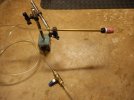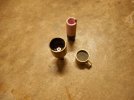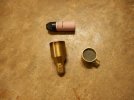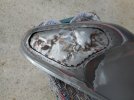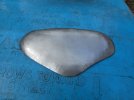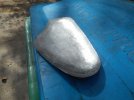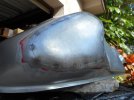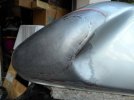Hi all, first post here. Before getting to that, I just want to give a big shout out to everyone and say thank you for making this such a kick ass, wealth of knowledge site. I honestly don't think I'd be attempting my current project without this place, so again a big thanks to you all.
My current project is rebuilding the entire front half of my 1988 Toyota 4wd std cab pickup, from the inner door pillar shells/firewall/fresh air duct halves on out. This obviously involves drilling out a slew of spot welds and filling a lot of them in so a smaller hole can be popped in....sorry, 11/32 is too big IMO for plug welding 20 gage. First thing I do is hammer and dolly out any deformations around the factory spots to make everything straight and ripple free as possible. I'll then weld the plugs in, all backpurged TIG (b/c unpurged is so ugly, not to mention all the suck-back that needs filling). Next, I'll rough everything down, leaving them about 10 thou proud or so. And then things get tricky, for me anyway, from here.
So usually, 9 times out of 10 I'll end up with some kind of distortion, as expected, from welding. If I were to just take everything flat with a roloc, I'd probably end up with a local area thickness of around 20-25 thou (or less) of the .035" I started with. I guess my question here is how do I planish this flat and straight when there's about .010" of weld left on both sides? Is it just a matter of grind, planish, wash and repeat until happy or have I missed something along the way? What's your procedure?
And while I'm on the subject, what is an acceptable amount of original thickness loss when dressing welds? I recently threw a mic over a finished area that started out about .0355". Think the thinnest I found was .0325" after finishing, just wondering if I need to tighten up my game or not.
My current project is rebuilding the entire front half of my 1988 Toyota 4wd std cab pickup, from the inner door pillar shells/firewall/fresh air duct halves on out. This obviously involves drilling out a slew of spot welds and filling a lot of them in so a smaller hole can be popped in....sorry, 11/32 is too big IMO for plug welding 20 gage. First thing I do is hammer and dolly out any deformations around the factory spots to make everything straight and ripple free as possible. I'll then weld the plugs in, all backpurged TIG (b/c unpurged is so ugly, not to mention all the suck-back that needs filling). Next, I'll rough everything down, leaving them about 10 thou proud or so. And then things get tricky, for me anyway, from here.
So usually, 9 times out of 10 I'll end up with some kind of distortion, as expected, from welding. If I were to just take everything flat with a roloc, I'd probably end up with a local area thickness of around 20-25 thou (or less) of the .035" I started with. I guess my question here is how do I planish this flat and straight when there's about .010" of weld left on both sides? Is it just a matter of grind, planish, wash and repeat until happy or have I missed something along the way? What's your procedure?
And while I'm on the subject, what is an acceptable amount of original thickness loss when dressing welds? I recently threw a mic over a finished area that started out about .0355". Think the thinnest I found was .0325" after finishing, just wondering if I need to tighten up my game or not.
Last edited:

